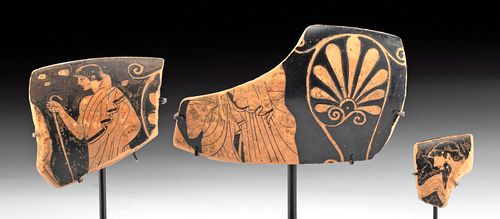Greek Attic Red-Figure Kylix Fragments - Douris Painter
Lot 24b
About Seller
Artemis Fine Arts
686 S Taylor Ave, Ste 106
Louisville, CO 80027
United States
Selling antiquities, ancient and ethnographic art online since 1993, Artemis Gallery specializes in Classical Antiquities (Egyptian, Greek, Roman, Near Eastern), Asian, Pre-Columbian, African / Tribal / Oceanographic art. Our extensive inventory includes pottery, stone, metal, wood, glass and textil...Read more
Categories
Estimate:
$8,000 - $15,000
Absentee vs Live bid
Two ways to bid:
- Leave a max absentee bid and the platform will bid on your behalf up to your maximum bid during the live auction.
- Bid live during the auction and your bids will be submitted real-time to the auctioneer.
Bid Increments
| Price | Bid Increment |
|---|---|
| $0 | $25 |
| $300 | $50 |
| $1,000 | $100 |
| $2,000 | $250 |
| $5,000 | $500 |
| $10,000 | $1,000 |
| $20,000 | $2,500 |
| $50,000 | $5,000 |
| $100,000 | $10,000 |
| $200,000 | $20,000 |
About Auction
By Artemis Fine Arts
Feb 13, 2020
Set Reminder
2020-02-13 10:00:00
2020-02-13 10:00:00
America/New_York
Bidsquare
Bidsquare : Exceptional Antiquities, Asian, Ethnographic
https://www.bidsquare.com/auctions/artemis-gallery/exceptional-antiquities-asian-ethnographic-4848
An important one-day auction featuring museum-worthy examples of Egyptian, Greek, Roman, Etruscan, Near Eastern, Far East / Asian, Pre-Columbian, African / Tribal, Oceanic, Native American, Spanish Colonial, Russian, Fossils, Ancient Jewelry, Fine Art, so much more! Artemis Fine Arts info@artemisgallery.com
An important one-day auction featuring museum-worthy examples of Egyptian, Greek, Roman, Etruscan, Near Eastern, Far East / Asian, Pre-Columbian, African / Tribal, Oceanic, Native American, Spanish Colonial, Russian, Fossils, Ancient Jewelry, Fine Art, so much more! Artemis Fine Arts info@artemisgallery.com
- Lot Description
Ancient Greece, Athens (Attic), attributed to Douris, ca. 480 to 470 BCE. The surviving pieces of this drinking cup depict the interaction between adult males and youths. Such subject-matter reflects the context and occasion in which the object would have functioned; as a vessel used for drinking wine, the kylix would have been a key component of symposia, male-only drinking parties held by Athenian citizens, where important political topics and philosophical matters were discussed in a convivial atmosphere. The depiction of younger men interacting with older men also suggests a didactic context. Douris was a prolific and influential painter of the red-figure technique, noted for his fine drawing style. A lovely ensemble of red-figure kylix fragments, each presented on a custom stand. Size: largest fragment measures 3.25" W x 2" H (8.3 cm x 5.1 cm); 3.25" H (8.3 cm) on included custom stand.
According to the Getty Museum, "One of the most prolific vase-painters known, Douris worked as a vase-painter and occasionally as a potter in Athens in the early 400s B.C. He is known from almost forty signed vases, two of which he also potted. Altogether, almost three hundred vases have been attributed to him. Given that scholars estimate a less than 0.5% survival rate for Greek vases, Douris may have decorated about 78,000 vases in his career. Douris primarily decorated red-figure cups, but he also painted a few vessels of other forms and in other techniques, including white-ground. His scenes are about evenly divided between mythology and depictions of everyday life. He worked with a number of potters, including Kleophrades and Euphronios, but he seems to have had a regular collaboration with Python. Onesimos depicted a cup signed by Douris on one of his vases, and there is even an ancient forgery of Douris's signature. These unusual references attest to Douris's significant influence among contemporary vase-painters."
These fragments were collected by Arthur Richter. Mr. Richter lived in Oakland, California and passed away in 2016. He worked with Frank Kovacs, the coin dealer, in his office from 1978-1983, where he managed the archaeology book and print department. When he visited Kovacs, he continued his own business selling books and prints primarily in the subject of archaeology and ancient art. This business was called Archaeologia, which he operated until his death, together with his business partner Andrew Gordon. Over the years he developed an interest in building some of his own collections, including coins. He had a particular passion for Greek vases and he lovingly acquired a collection of Greek pottery sherds and fragments for many years, especially throughout the 1980s and 1990s.
Provenance: ex F. Schultz, New York, USA, early 1980s; ex A.S. Richter collection, California, USA (see more about Mr. Richter in the description above)
All items legal to buy/sell under U.S. Statute covering cultural patrimony Code 2600, CHAPTER 14, and are guaranteed to be as described or your money back.
A Certificate of Authenticity will accompany all winning bids.
We ship worldwide and handle all shipping in-house for your convenience.
#152759Fragments from a larger vessel as shown. Normal surface wear commensurate with age; however, the imagery is still very good. Scattered deposits grace the surfaces.Condition
- Shipping Info
-
All shipping is handled in-house for your convenience. Your invoice from Artemis Gallery will include shipping calculation instructions. If in doubt, please inquire BEFORE bidding for estimated shipping costs for individual items.
-
- Buyer's Premium



 EUR
EUR CAD
CAD AUD
AUD GBP
GBP MXN
MXN HKD
HKD CNY
CNY MYR
MYR SEK
SEK SGD
SGD CHF
CHF THB
THB













